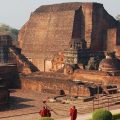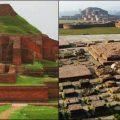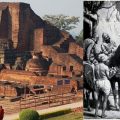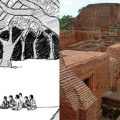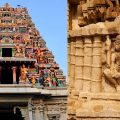Why Name of Bakhtiyarpur Junction in Bihar be Immediately Changed
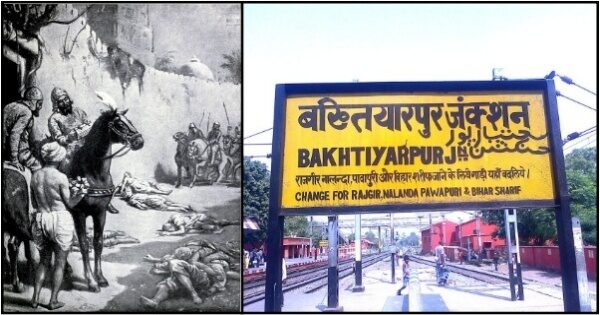
Have you ever heard about any country celebrating the barbarism of invaders as its glory? This happens only in India! Across the length and breadth of India are roads and buildings named after invaders. Railway stations are no different! Bakhtiyarpur Junction that connects with Delhi-Kolkata main line, located in Bakhtiarpur city in the district of Patna in Bihar is named after Bakhtiyar Khilji, the destroyer of India’s knowledge heritage. Bakhtiyar Khilji not only destroyed Nalanda University and burned the three multi-storey libraries in the campus but also involved in genocide of Hindus and Buddhists, numbering to thousands at the same site. He also destroyed Vikramshila University, Odantapuri University, and more ancient heritage structures. While history textbooks don’t teach about the atrocities committed by Khilji, we, Indians continue celebrating their glory every day. It is high time the name of Bakhtiyarpur Junction railway station be changed.
India is home to numerous ancient universities, from the north to south, east to west. Students from across the world came and studied in these learning centres. Nalanda University is located in the ancient kingdom of Magadha, presently seven miles north of Rajgriha in Bihar, and not very far from Bakhtiyarpur Junction. A seal identifying a monarch named Shakraditya believed to be Kumaragupta I, a Gupta emperor, is considered the founder of Nalanda University. According to Vedveer Arya’s book Chronology of India, the Gupta era commenced from 335 BCE. As the foundation of Nalanda University was laid by a Gupta Emperor, this learning centre flourished from the last years of BCE. This means Nalanda University is over 2000 years old! Recorded evidences suggest existence of a smaller learning centre when the Gupta emperor laid the foundation of the learning centre here. It was a principal seat of learning, attracting students from as far as Tibet, China, Greece, and Persia, and beyond until the Turkish invasion of 1193.
To quote AICTE on Nalanda University from its article on ‘Ancient Universities in India’,
“The center had eight separate compounds, 10 temples, meditation halls, classrooms, lakes and parks. It had a nine-story library where monks meticulously copied books and documents so that individual scholars could have their own collections. It had dormitories for students, perhaps a first for an educational institution, housing 10,000 students in the university’s heyday and providing accommodations for 2,000 professors. Nalanda University attracted pupils and scholars from Korea, Japan, China, Tibet, Indonesia, Persia and Turkey.”
Nalanda University followed highly formalized methods of Vedic learning besides teaching the principles of Buddhism. Nalanda attracted Buddhist monks from far and near, as its was the birthplace of Gautam Buddha’s favorite disciple Sariputta. This led to construction of several viharas and grew in importance as a centre of the Mahayana branch of Buddhism. There have been evidences of kings from foreign lands donating for the building of structures within the Nalanda University complex. There is archaeological evidence of a Shailendra king of Indonesia who built a structure within the campus. Such was the prominence of Nalanda University far and wide. Ironically, we have a railway station – Bakhtiyarpur Junction in the name of the destroyer of this famous ancient learning centre.
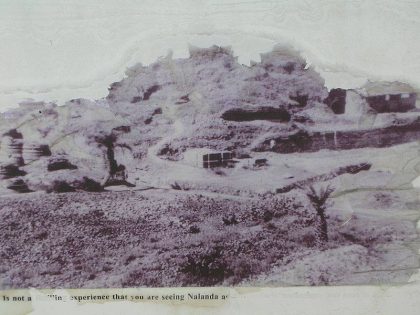
Nalanda University before excavations; image source: Wikimedia.
It has been wrongly misinterpreted that Nalanda University was only a seat of Buddhist learning. The many sculptures of the Hindu pantheon of deities found at the site during excavations tell a different story. All ancient subjects including Vedas, Upanishads, Buddhist scriptures, Mathematics, Logic, Sanskrit Grammar, Medicine, Samkhya, Vastu Shastra, etc. were taught at this ancient university of India. To quote from The Continuum Companion to Hindu Studies edited by Jessica Frazier and Gavin Flood,
“The highly formalized methods of Vedic learning helped to inspire the formation of large teaching centres – effectively India’s first universities. Taxila, Nalanda and Vikramaalla are the most famous of these, the latter two surviving until the thirteenth century. Such universities taught not only the Vedic texts and the ritual that complemented them, but also the various theoretical disciplines that provided a foundation for these two pillars, the Vedangas, or sciences (literally ‘limbs’ or ‘supports’) of the Vedas. These included linguistics, reasoning (helm, literally, ’causes’), medicine, law, astronomy and city-planning. Sastras attempted to collect and represent distinct fields of knowledge, creating a cultural template of classic ‘disciplines’ such as law and ethics (dharma-sastra), economics and governance (artha-sastra), drama and aesthetics (natya-sastra), religious architecture (vistu-sastra) and of course grammar. In both the Sutras and more explanatory Sastras, diverse views were considered and assimilated to a single relatively coherent system, systematically explained.”
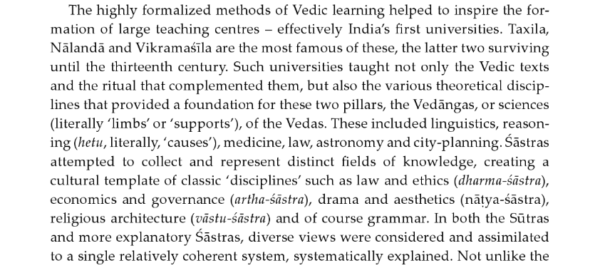
Extract from ‘The Continuum Companion to Hindu Studies’ edited by Jessica Frazier and Gavin Flood.
Admission in Nalanda University was tough. Students had to sit for an entrance exam. According to an account by Chinese traveler, Buddhist scholar, and translator Hieun-Tsang, only about 20 percent of the students who sat for the entrance tests, succeeded. The eligibility criteria on age was set at twenty years. Education was provided free of cost. There were three methods of teaching, namely verbal and explanatory, lectures and debates and discussions. Around a 100 lectures were delivered everyday and it was compulsory for the students to attend the lectures.
This centre was a residential seat of learning and the campus contained 10 temples, classrooms, meditation halls, monasteries, dormitories, etc. including lakes and parks spread across eight compounds. The university accommodated over 10,000 students and 2,000 teachers. According to traditional Tibetan sources, the library at Nalanda University was spread over three large multi-storeyed buildings. One of these buildings had nine storeys that housed the most sacred manuscripts. To quote Paul Monroe’s Encyclopaedia of History of Education, Volume 1:
We have already seen that I-tsing stayed for his studies at Nalanda for the long period of ten years (A. D. 675-85), during which he collected there some 400 Sanskrit texts amounting to 500,000 slokas (p.xvii). This shows that Nalanda possessed a well-equipped library. Information on the Nalanda University Library is given in the Tibetan accounts, from which we know that the Library, situated in a special area known by the poetical name of Dharmaganj a (Mart of Religion), comprised three huge buildings, called Ratnaagara, Ratnodadhi, and Rat-naranjala, of which Ratnasagara, which was a ninestoreyed building, specialized in the collection of rare sacred works like Praniapa-ramtia-sutra and Tantrika books like Samajaguhya and the like.
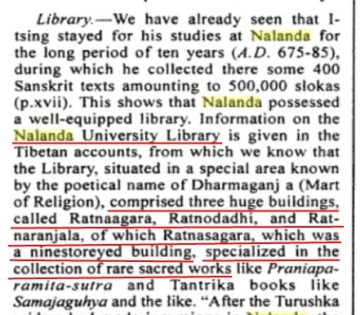
Description about Nalanda University Libraries in the book ‘Paul Monroe’s Encyclopaedia of History of Education, Volume 1’ by Paul Monroe.
Nalanda University was destroyed by Bakhtiyar Khilji, a Turkish Muslim plunderer, in 1193 AD. He set fire to the libraries and killed the Acharyas and students. This is described by Minhaj-i-Siraj in his book Tabaqat-i Nasiri. The manuscripts burnt for several months, as evidenced by the huge heaps of layers of ash discovered at the site during excavations. This also proves that Nalanda University libraries accommodated lakhs of manuscripts. Such a huge loss of India’s ancient knowledge heritage! It is India that continues to glorify the plunderer Khilji. Bakhtiyarpur Junction and even the city of Bakhtiyarpur, a Vidhan Sabha constituency today, continues to haunt generations with many oblivious of the atrocities commited by Khilji on Indian heritage and the native population. Thanks to the education system where only a one-sided and distorted historical narrative is taught!
Minhaj-i-Siraj wrote of this attack in his book Tabaqat-i Nasiri translated by Raverty:
“Muhammad-i-Bakht-yar, by the force of his intrepidity, threw himself into the postern of the gateway of the place, and they captured the fortress, and acquired great booty. The greater number of the inhabitants of that place were Brahmans, and the whole of those Brahmans had their heads shaven; and they were all slain. There were a great number of books there; and, when all these books came under the observation of the Musalmans, they summoned a number of Hindus that they might give them information respecting the import of those books; but the whole of the Hindus had been killed. On becoming acquainted [with the contents of those books], it was found that the whole of that fortress and city was a college, and in the Hindui tongue, they call a college Bihar.”
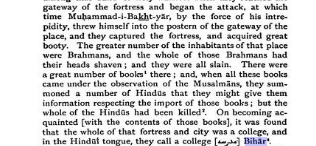
Extract from book ‘Tabaqat-i Nasiri’ translated by Raverty
Minhaj-i-Siraj also wrote in his book Tabaquat-I-Nasiri about thousands of monks being burned alive and thousands beheaded as Khilji tried his best to uproot Buddhism and plant Islam by the sword. The burning of the library continued for several months and ‘smoke from the burning manuscripts hung for days like a dark pall over the low hills.’
Imparting of education continued the small way after repairs for the next few hundred years. Dharmasvamin, a Tibetan monk-pilgrim, who studied at Nalanda University after its destruction, gives a detailed account about the learning centre and further attacks by Islamic plunderers in his autobiography. He mainly visited Bodh Gaya and Nalanda. It was in April 1235 that he came to Nalanda to study. Rahula-sri-Bhadra, aged 90 years, was the head Guru and a specialist in grammar. There were still 70 students studied under him. Dharmasvamin completed his studies in a year. The Guru also knew Tibetan. To quote from Biography of Dharmasvamin (Chag lo tsa-ba Chos-rje-dpal) translated by Dr George Roerich with a historical and critical introduction by AS Altekar:
He then went to Nalanda to study under Rahula-sri-Bhadra, who was the head abbot and more than 90 years in age. He was a specialist in grammar and there were still 70 students reading under him.1 He also knew Tibetan well, for he assisted Dharmasvamin in translating Kalachakravatia into Tibetan during the latter’s stay at Nalanda. His new Guru did not want him to spend a second vassa in India, as a year before a Tibetan monk reading with him had died of high fever; he therefore pressed him to return to Tibet. But Dharmasvamin was not anxious to cross the Ganga in the rainy season and preferred to spend it at Nalanda in order to complete his studies. As apprehended by his Guru he however fell ill; his body was covered all over with boils, which caused intense pain. He however recovered, though he continued to be very weak. In spite of his illness and weakness, in spite of the Muslim onslaughts off and on, he continued his studies at Nalanda, till they were completed, probably by March 1236. He then begged permission of his Guru to return to Tibet, but the latter affectionately detained him for a month and then gave him a send off, saying I am old and Tibet is far away. We shall not meet in this life; we shall meet in Sukhavati.”
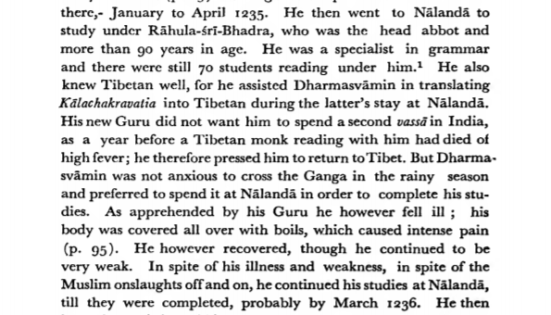
Extract from ‘Biography of Dharmasvamin (Chag lo tsa-ba Chos-rje-dpal)’ translated by Dr George Roerich with a historical and critical introduction by AS Altekar.
When Dharmasvamin visited Nalanda University after its destruction by Bakhtiyar Khilji, the campus was ‘a mere ghost of its past glory’. According to Dharmasvamin’s account, the university premise once had seven temples and 14 big and 84 small monasteries. Dharmasvamin further wrote that ‘they were damaged by the Muslims and there was none to look after them or to make offerings’. The Tibetan monk pilgrim came across two Viharas called Dha-na-ba and Ghu-na-ba in a serviceable condition and found Rahula-sri-Bhadra teaching around 70 students. Had not Bakhtiyar Khilji and other Islamic plunderers destroyed this site, the history of the region would have been different!
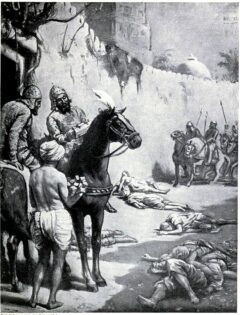
An image from the chapter on India in Hutchison’s Story of the Nations edited by James Meston, depicting Bakhtiyar Khilji’s massacre of students and teachers at Nalanda University site. Image source: Wikimedia.
Why name a region as Bakhtiyarpur and a railway station as Bakhtiyarpur Junction in the name of the destroyer of our knowledge heritage? Why is the right history about Bakhtiyar Khilji and his atrocities not taught to Bharatiyas. Does history books reveal to us about Khilji’s defeat in the hands of Assam king Prithu after which he remained bedridden till his death? As Marcus Garvey, a Jamaican born political activist and social worker rightly says, “A people without the knowledge of their past history, origin, and culture is like a tree without roots.” It is time truth is told! It is high time the names of Bakhtiyarpur and Bakhtiyarpur Junction be changed!!
Featured image courtesy: Wikimedia.
Ref:
1. Tabkat-i-Nasiri by Minhaj-Us Siraj; translated by HM Elliot, John Dowson
2. ‘Paul Monroe’s Encyclopaedia of History of Education, Volume 1′ by Paul Monroe.
3. Biography of Dharmasvamin (Chag lo tsa-ba Chos-rje-dpal) translated by Dr George Roerich with a historical and critical introduction by AS Altekar.
4. The Continuum Companion to Hindu Studies edited by Jessica Frazier and Gavin Flood.
5. Chronology of India by Vedveer Arya
6. Saffron Swords by Manoshi Sinha.

